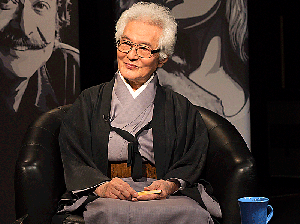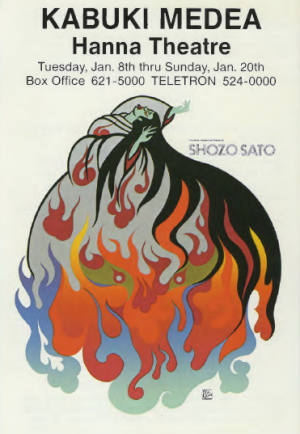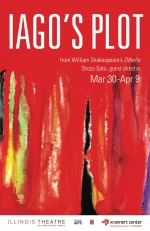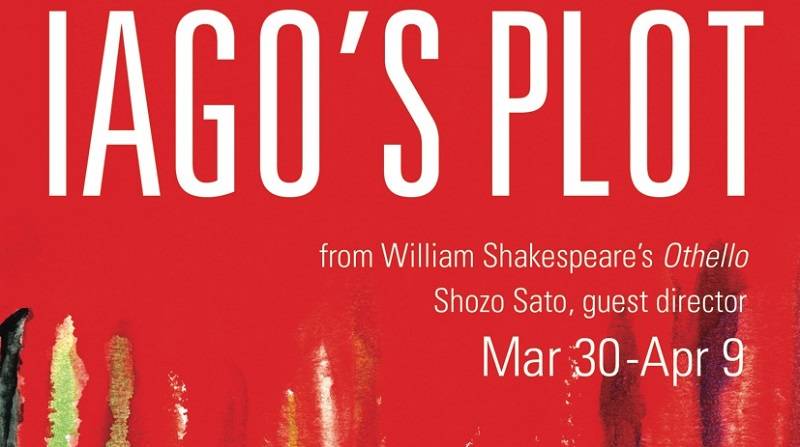From March 29 to April 9, the Studio Thetare of Urbana’s Krannert Center, will showcase the return of the dazzling directorial style of Shozo Sato with “Iago’s Plot”–that is the good news. The bad news—his brilliance as a director and designer is no secret and every performance is sold out with waiting lists.
 One factor is the limited seating of the Studio Theatre, but the story of his ability to fill theaters of American audiences to traditional Western stories designed and directed in Kabuki style goes well beyond small theater venues. The story of this remarkable artist and his educational outreach to the West of the fine points of Japanese culture begins in the 1960s. In 1964, he came to the University of Illinois as an artist-in-residence.
One factor is the limited seating of the Studio Theatre, but the story of his ability to fill theaters of American audiences to traditional Western stories designed and directed in Kabuki style goes well beyond small theater venues. The story of this remarkable artist and his educational outreach to the West of the fine points of Japanese culture begins in the 1960s. In 1964, he came to the University of Illinois as an artist-in-residence.
In 1965, he published the first of his several books on Japanese culture, The Art of Japanese Flower Arrangement, Japanese Ikebana. The book became a cult classic and collectable first printings can sell for up $160. Critics and academics were impressed at his ability to explain Japanese traditions and noted his personal design work on the book. In 1968, he joined the faculty of the University of Illinois as Professor of Arts and Design, a position he would hold until 1992.
In 1969, when the Krannert Center opened, he was named Artist-in-Residence. There, he would spend a career blending Western ideas with Japanese culture, and he would he would do it brilliantly. In addition to his teaching, he opened Japan House, now located on north Lincoln avenue near the Arboretum and began adapting western plays and legends to Kabuki performance style.
During his first decade, Kabuki style performances of Madame Butterfly, The Mikado and Kabuki Macbeth graced the stages of the Krannert Center. The praise that greeted Kabuki Macbeth did not go unnoticed by University of Illinois graduate, Robert Falls. He was then the Artistic Director of Chicago’s Wisdom Bridge Theatre, and he invited Professor Sato to stage the play in Chicago.
 The production was a sensation and the production won three Joseph Jefferson Awards, the highest honor of the Chicago theater community. Professor Sato won two of those coveted awards himself for design and direction. When his next big project, Kabuki Medea, moved from Krannert to the Chicago area, it grabbed six Joseph Jefferson awards, with the master of many trades, Shozo Sato, taking three of them himself for costume design, direction and incidental music.
The production was a sensation and the production won three Joseph Jefferson Awards, the highest honor of the Chicago theater community. Professor Sato won two of those coveted awards himself for design and direction. When his next big project, Kabuki Medea, moved from Krannert to the Chicago area, it grabbed six Joseph Jefferson awards, with the master of many trades, Shozo Sato, taking three of them himself for costume design, direction and incidental music.
Kabuki Medea gathered such national attention it lit up many venues, including Washington D.C.’s Kennedy Center, where it received the poster design award. Any guess who designed that poster? Yes, among his many contributions to his productions, Sato designs his posters.
 The 1980s saw the publication of The Art of Sumi-E—Appreciation, Techniques and Applications and more stage creations in Kabuki style of such works as Kabuki Faust and Kabuki Othello. Even as he neared retirement, he was in demand as a director of his stage creations and added an adaptation of the Achilles legend to the mix.
The 1980s saw the publication of The Art of Sumi-E—Appreciation, Techniques and Applications and more stage creations in Kabuki style of such works as Kabuki Faust and Kabuki Othello. Even as he neared retirement, he was in demand as a director of his stage creations and added an adaptation of the Achilles legend to the mix.
In 1991, he took Achilles, a Kabuki Play to Japan. This was the first time American actors had performed Kabuki in Japan. In 1999, he was named Professor Emeritus and received an honorary degree of Doctor of Fine Arts from the University of Illinois.
 Honors and decades of work did not diminish his dedication to the arts. He returned to the Krannert Center in 2012 to stage Kabuki Lady Macbeth, published a new book 2014 on Japanese Zen Calligraphy, and now brings us Iago’s Plot in 2017.
Honors and decades of work did not diminish his dedication to the arts. He returned to the Krannert Center in 2012 to stage Kabuki Lady Macbeth, published a new book 2014 on Japanese Zen Calligraphy, and now brings us Iago’s Plot in 2017.
Bill Downs and Lou Anne Wright, who collaborated with Professor Sato on Kabuki Medea and Kabuki Faust beautifully summarized the qualities that made Shozo Sato such a great artistic bridge—“Here is a great visual artist who translates cultures into theatrical arts seamlessly. He opens a cultural door for many who would not have access to it”. Once more, with Iago’s Plot, Shakespeare and Kabuki return to the Krannert Center as east meets west.
 Bill reminded me of how Shozo Sato worked with his western collaborators so successfully. When Bill asked how to write a Kabuki stage story, Sato said—“Don’t worry, just write the script, I’ll put the soy sauce on it”.
Bill reminded me of how Shozo Sato worked with his western collaborators so successfully. When Bill asked how to write a Kabuki stage story, Sato said—“Don’t worry, just write the script, I’ll put the soy sauce on it”.
Iago’s Plot will be staged at the Krannert’s Studio Theatre from March 29 to April 9. Wth all performances sold out, you can get on the waiting list by calling 217-333-6280, or going to Krannert’s website.








